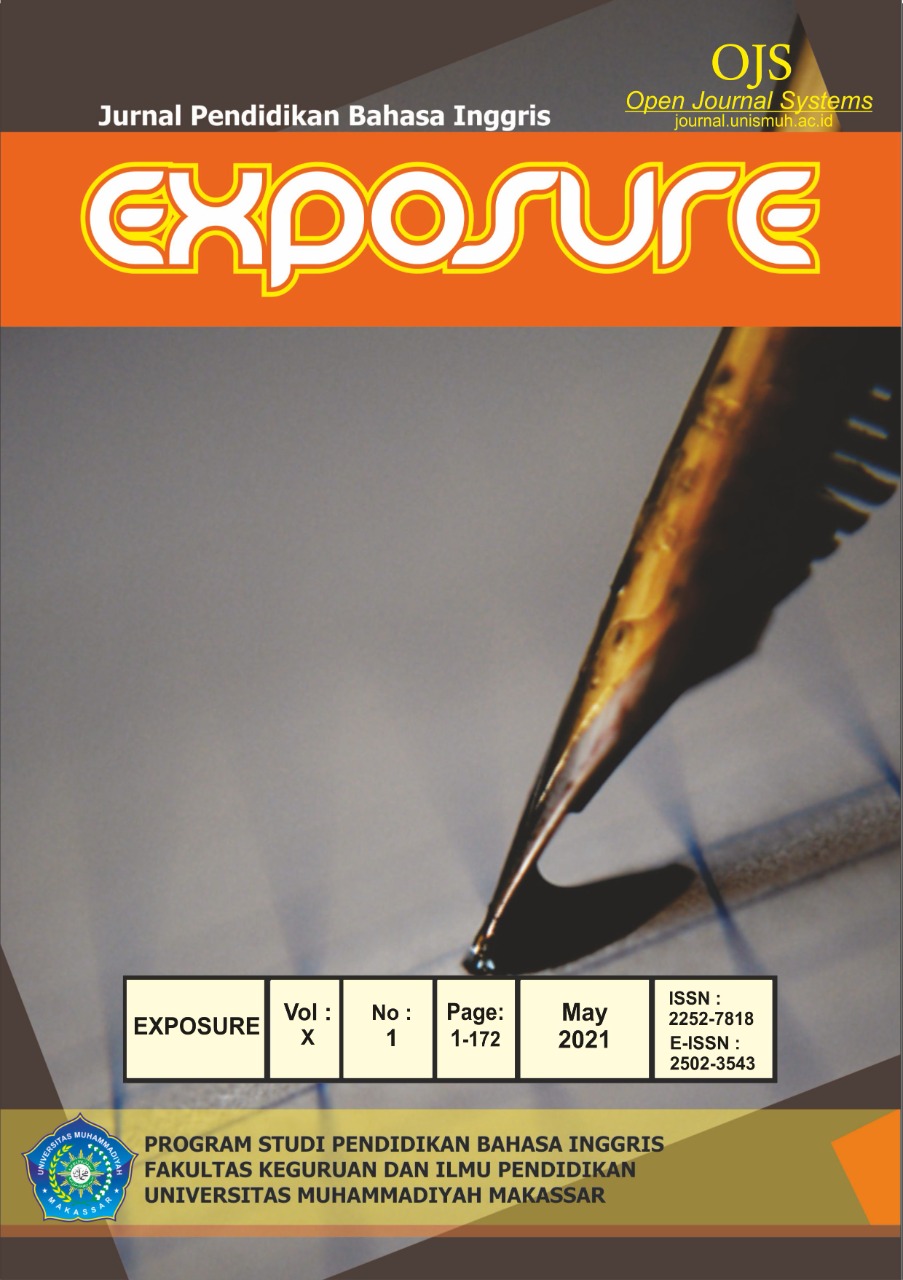POINT-COUNTER-POINT STRATEGY TO ELEVATE STUDENTS’ WRITING PERFORMANCE BY USING VIDEO-BLOG
DOI:
https://doi.org/10.26618/exposure.v10i1.5050Keywords:
Point Counter Point Strategy, Video Blog, Writing PerformanceAbstract
This research was finding out the learners’ writing performance through point-counterpoint strategy by using video blog. The aims of this research were: 1) to find out whether or not the point-counterpoint strategy through video blog elevate the learners’ writing performance, and 2) to find out the learners’ interest toward the use of video blog through point-counter-point strategy in teaching writing performance. Pre experimental design is carried out by the researcher in this research. The sample of this research was XI IPA2 (33 learners). This sample was taken by the random sampling technique. This research applied two kinds of instruments were writing test and questionnaire in this research.The result of this research shows that the learners’ performance is better writing after they taught by using point-counter-point strategy through video blog at SMA Negeri 3 Polewali Mandar. It was proved by the mean score of the post-test was higher than the pre-test (81.96>68.03). So, the researcher stated that H0 was rejected and H1 was accepted. And the researcher also found that the eleventh-grade learners at SMA Negeri 3 Polewali Mandar were interested in teaching writing performance. It was proved by the mean score of the questionnaire was 80.21 and it was classified in the interesting category.
References
Alfina, L. (2013). The Effect of Using Point-Counter-Point Strategy toward Reading Comprehension of the Second Year Learners at SMAN 3 Siak Regecy. UIN Suska Riau.
Campbell, A. P. (2003). Weblogs for Using with ESL Classess. The Internet TESL Journal.
Fidan, M., & Debbag, M. (2018). The Usage of Video Blog (Vlog) in the “School Experience” Course. The Opinions of the Pre-Service Teachers.
Hadi, S., & Ikhsan, KN. (2013). Implementasi dan Pengembangan Kurikulum 2013.
Handayani, E. (2017). Pengaruh Strategi Pembelajaran Aktif Tipe Point Counterpoint menggunakan Poster Session Terhadap Hasil Belajar Biologi Siswa Kelas X SMA Negeri 3 Bulumba. UIN Alauddin Makassar.
Harmer, J. (2008). How to Teaching Writing. Pearson Education Limited
Lestari, N. (2019). Improving the Speaking Skill by Vlog (Video Blog) as Learning Media: The EFL Learners Perspective.
Noviani, L., Joyoatmjo, S., & Abdillah, R. (2010). Pemanfaatan Blog Sebagai Media Pembelajaran dalam Meningkatakan Prestasi Belajar Siswa. Universitas Sebelas Maret.
Sa’diyah. (2011). Improving Learners’ Ability in Writing Descriptive Texts through a Picture Series-Aided Learning Strategy. XL, 164–182. www.melta.org.my/ET/2011/164_182.
Sari, P. (2017). Using Vlog in the Youtube Channel as a Means to Improve Learners’ Motivation and Confidence to Speak English in Intermediate 1 Level of LB-LIA Jambi. International Journal of English Language and Teaching.
Sejnost, R, L. (2010). Building Content Literacy (Sage Compa).
Sun, Y, C. (2010). Extensive writing in foreignlanguage classrooms: A blogging approach. Innovations in Education and Teaching International, 327–339.
Trisulari, F, R. (2019). The Effectiveness of Point Counter Point Strategy on Learners; Speaking Achievement at the 11th Grade of MA Terpadu Al Anwar Durenan Trenggalek
Wallis. (2006). Teaching and Learning Strategies that Foster Comprehension.
Downloads
Published
Issue
Section
License
Authors who publish with this journal agree to the following terms:
In order to assure the highest standards for published articles, a peer review policy is applied. In pursue of the compliance with academic standards, all parties involved in the publishing process (the authors, the editors and the editorial board and the reviewers) agree to meet the responsibilities stated below in accordance to the Journal publication ethics and malpractice statement.
Duties of Authors:
- The author(s) warrant that the submitted article is an original work, which has not been previously published, and that they have obtained an agreement from any co-author(s) prior to the manuscript’s submission;
- The author(s) should not submit articles describing essentially the same research to more than one journal;
- The authors(s) make certain that the manuscript meets the terms of the Manuscript Submission Guideline regarding appropriate academic citation and that no copyright infringement occurs;
- The authors(s) should inform the editors about any conflict of interests and report any errors they subsequently, discover in their manuscript.
Duties of Editors and the Editorial Board:
- The editors, together with the editorial board, are responsible for deciding upon the publication or rejection of the submitted manuscripts based only on their originality, significance, and relevance to the domains of the journal;
- The editors evaluate the manuscripts compliance with academic criteria, the domains of the journal and the guidelines;
- The editors must at all times respect the confidentiality of any information pertaining to the submitted manuscripts;
- The editors assign the review of each manuscript to two reviewers chosen according to their domains of expertise. The editors must take into account any conflict of interest reported by the authors and the reviewers.
- The editors must ensure that the comments and recommendations of the reviewers are sent to the author(s) in due time and that the manuscripts are returned to the editors, who take the final decision to publish them or not.
Authors are permitted and encouraged to post online a pre-publication manuscript (but not the Publisher’s final formatted PDF version of the Work) in institutional repositories or on their Websites prior to and during the submission process, as it can lead to productive exchanges, as well as earlier and greater citation of published work (see The Effect of Open Access). Any such posting made before acceptance and publication of the Work shall be updated upon publication to include a reference to the Publisher-assigned DOI (Digital Object Identifier) and a link to the online abstract for the final published Work in the Journal.

